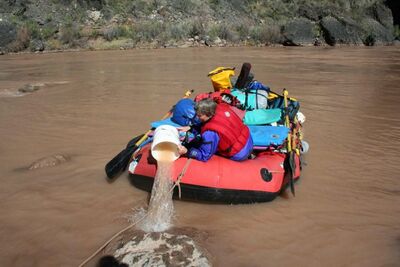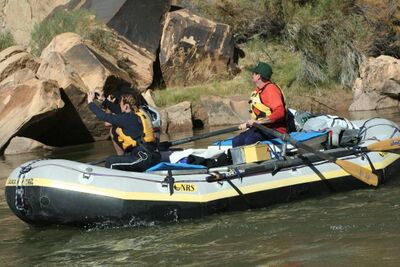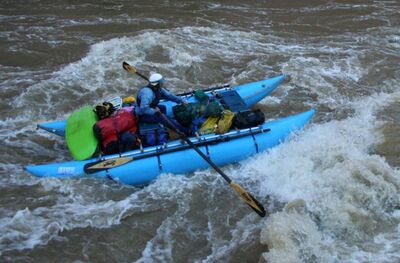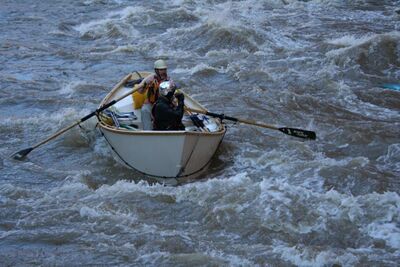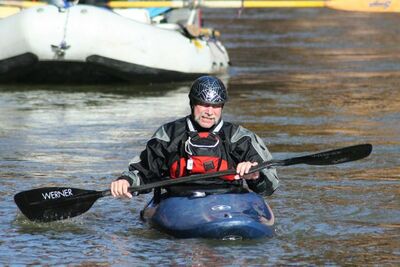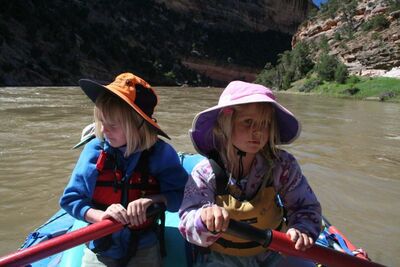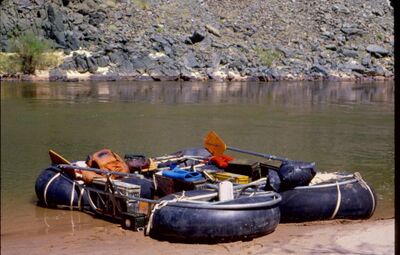Watercraft
So what kind of boat should I bring for the Grand? That’s a good question. The Colorado River in Grand Canyon, from Lee’s Ferry to South Cove, is 297 miles long, and can take up to four weeks to travel from end to end. The watercraft your trip brings will need to carry all the people on the trip as well as your food, refuse and solid waste, and all the cooking and camping gear.
The variety of watercraft used by river runners is fairly broad. Some folks bring self bailing rafts, while some folks bring non-self bailing rafts (called bucket boats as you have to bail them out with a bucket). Some folks bring catarafts, a frame with a tube on either side of the frame suspending the load. These are often called cats. Some folks bring hard body kayaks, some bring inflatable kayaks, and some bring hard hull dories. Canoes are also used but requires the use of float bags to avoid filling with water and is a topic all of its own. This discussion of watercraft will be limited to muscle powered watercraft.
It may be obvious that almost all groups will need large rafts to carry the group gear. What may not be so obvious is the Colorado River is a big river and it can take a long time to row over to pick up a swimmer especially in a large gear boat. How long are you comfortable with someone being in the water? If it is really hot it may be difficult for everyone to be in full dry suits or wet suits all the time.
A good leader and group will consider the advantages and disadvantages of each boat and try to assemble a combination that will enhance each other. First start with the available boats from the participants in the group. Not only will this save money from renting all your boats but the owner should be familiar with packing the boat and how to row or paddle it which has significant advantages. Sure that rental boat may be bigger and carry more gear but a smaller raft that has been optimized through experience may not require as much gear. Also consider the participants. Is avoiding flipping as much as possible important? Once available boats are considered then the group can be filled out with rental boats.
There are many pros and cons for each type of watercraft. We’ll try to cover some of them here. The bottom line is this; the boat you like may be the boat someone else does not. Let them row their boat, and you row yours. The worst tracking heaviest boat can effortlessly travel through Grand Canyon at the hands of a skilled person rowing that pig, er, boat.
Bucket Boats
Non self bailing rafts must be bailed, typically with a bucket, hence the name bucket boat. Bucket boats in the 12 to 18 foot range used to be very popular until the self bailing boats arrived on the boating scene. Still today, some river runners are going back to bucket boats for their tracking capabilities. These boats can carry an impressive amount of trip gear and can be very easy to rig. This type of boat can also serve as a paddle boat when used without a frame, allowing up to seven people, each with a paddle, to participate in maneuvering the boat.
There are downsides to bucket boats, just like there are downsides to every type of boat. Putting a hole through the flooring material is easier than in self bailing boats. Care must be taken to keep shoes and equipment clean when getting into and out of the boat, and any dirt or small gravel that makes its way into the boat will become lodged in the floor seam and cause wear at the seam. An advantage with a bucket boat is when it fills with water it acquires a huge amount of momentum that will help to punch through big waves and holes. The disadvantage is that once it fills with water it is harder to avoid those big holes waves. Then there is the bailing. It can take up to 20 minutes to bail out a fully swamped 16 foot bucket boat, using a 5 gallon bucket, as this photo below Lava Falls shows.
Self Bailing Rafts
For their size, self bailing rafts in the 12 to 18 foot range are very popular. They require no bailing, and cleaning them out when someone walks across your boat with muddy shoes (a no no) is easy. You just grab a bucket and wash the muck out the bottom of the boat. When overtopped by a big wave and full of water, the “Lazarus” effect takes over, as the boat will self bail itself and slowly rise up out of the water all by itself. Self bailing floors are very rugged and can tolerate going over rocks fairly well. The ribbed floor in some self bailing boats causes better tracking according to some rafters, and worse tracking according to others. Self bailing rafts are fairly straight forward to rig. This type of boat can also serve as a paddle boat when used without a frame, allowing up to seven people, each with a paddle, to participate in maneuvering the boat.
That said, there are a few downsides to the self bailers. You must take care of the floor valve, used to get air into the floor. This valve need to be kept accessible. There may be a built in pop-off valve to prevent over pressuring the floor. These valves can stick open when exposed to mud. The top of the self bailing floor is susceptible to puncture.
Both bucket boats and self-bailing boats can carry a large amount of gear. On the other hand they have a lot of drag with the tubes and floor in contact with the water which makes them slow when trying to row. This makes them less desirable in rescue situations since it can take some time to get to someone. In some case it may be impossible to row upstream to get someone.
Catarafts
Catarafts, or cats, consist of two parallel outboard air chambers suspending an inboard frame loaded with gear. The tubes tend to be larger than in self-bailing or bucket boats to compensate for the loss of floatation from the front and back tubes and the floor. If rigged well, they can carry an impressive amount of gear. They are self bailing, and as they do not have a full floor like the self bailing and bucket boat rafts, their ability to handle large pushy waves is somewhat better. The cat’s ability to plow through waves instead of going up and over them can give a more thrilling ride. One of the cat’s advantages is they come in component parts, each part weighing much less than a rolled up raft. This makes them easier to store, get into/out of a vehicle, and assemble.
Cats typically require more straps than rafts, and require you to track all the various component parts. Leaving one of the side tubes back home is a real problem. Since cats do not have a contiguous floor, if you drop something and it finds its way through your gear to the river below, losing gear out the bottom of the boat can be a problem.
Cats generally do not carry as much gear as a similar sized raft, unless attention is paid to how the frame is constructed. A 14 foot cat is not going to be able to carry much group gear. The floor in a cat is suspended above the water and can be wood, metal or mesh. The floor also may only be big enough for the rower. The key is the floor and gear is not dragging in the water so the only drag in a cat is from the two tubes. This makes cats very quick and maneuverable when rowing. When not rowing they are slower since they have less contact with the current in the river. With less floor cats provide a very wet ride compared to other rafts. While self-bailing rafts will fill with water and lose maneuverable during the time it takes for the water to flow back out through the floor, cats empty almost immediately. This makes cats excellent for use during rescues. They may be able to row upstream in places where other rafts cannot.
Dories
The hard hulled dory arrived on the Grand Canyon scene in the mid 1950’s when Moulty Fulmer rowed his boat the GEM through Grand Canyon in 1955. Rubber in rafts is flexible and when going against the current they bend and catch the water which increases drag. Dorys have much less flex than a rubber raft and are much more maneuverable. They can carry an impressive amount of gear, and have what is considered to be the best ride through a rapid of all the Canyon boats. They take the least rigging of all the rafts and are typically ready to head downriver once unloaded into the water. Their watertight compartments are a great place to store food that needs to be kept cool, dry and out of the sun.
Like all Grand Canyon watercraft, dories have their downsides as well. They need constant cleaning, and unlike rafts, do not play well with moderate contact with rocks. This can limit campsite selection or require special mooring when camp is at a rocky beach with surging wave action. Often a rubber raft is tied up against the shore and the dory is tied up to the outside of the raft to avoid abrasion against rocks. They can be a little more unstable and prone to flipping more than rubber rafts. Most dories require their own boat trailer, and do not carry a cooler.
Kayaks
Kayaking the Grand Canyon can be a very rewarding experience. Kayaks can also carry an impressive amount of personal gear, especially the older longer kayaks, although they are not very good for carrying group gear. Kayaks are extremely maneuverable and are able to assist in the rescue of swimming rafters.
The drawbacks to kayaking the Grand Canyon are the miles and miles of flatwater. It is also important to have a fairly strong roll if you don’t plan to do a lot of swimming. Even the eddy fences in the Grand Canyon can easily roll a kayak. Kayaks can become uncomfortable if you have tight hamstrings, as you will be spending may hours sitting upright with your legs out in front of you with only a limited ability to sit back and relax
Kayaks are great for rescue but if there is just one kayak who is going to rescue them? A group with just one kayak is common but these are very good kayakers. For kayakers that are not as good it is recommended that there be at least two kayakers on a trip.
Kayaks are also excellent for scouting ahead for campsites and landing spots. If they pass the best spot they may be able to paddle back upstream or carry the boat back up. This avoids blowing by a campsite because a raft cannot get back upstream.
For additional information on Kayak Self-Support trips, click here.
Boat Size
Larger boats can carry more gear. But big heavy boats require more effort to row and are less fun. So what are your group's priorities? Do you want all the creature comforts in camp or do you look forward to having a fun raft to row? Smaller also generally means more likely to flip. Maybe you have some people that would like a big stable boat with a lot of gear and others that want something more maneuverable and can provide safety for the rest of the group. Combining types of boats provides a mix of capabilities and is often the best approach.
Learning to Row
Getting stick time, or spending time rowing your boat, is important. The more comfortable you are rowing your boat, the more comfortable your Grand Canyon river trip will be. Remember, everyone has a “first time” rowing the Grand. Your familiarity with how to row your boat can come by direct experience on the Grand, or it can come from running your local river. As a general rule, the more comfortable you are rowing your boat and being able to read water before showing up at the Lee’s Ferry put-in, the easier time you will have rafting Grand Canyon. Practice makes perfect.
Other Watercraft Options
Please keep in mind that we have just covered the more traditional types of boats you will see on a do-it-yourself trip. There are other types out there, and that includes the 5% of trips that use motorboats. We do not recommend this type of watercraft for the preservation of the wilderness character of Grand Canyon. That said, there are other options still, including stand up paddle-boards. Here's one of the few photos of the Death Star series of boats. The two Stars have been joined together after the loss of an oar back upstream. This watercraft was called the Death Star Duplex or Death Star Deluxe, and is from a trip sans-permit in 1981. As far as we know, this line of boats only made one or two trips. While we DO NOT recommend or suggest you consider a sans-permit river trip, messing about with boat types and designs has a long tradition, and is how we go to where we are today. Remember, this is all supposed to be a lot of fun! Death Star Deluxe Photo Copyright Mark Scanlon.
Click here to return to The Pre-Trip Planning page.
Click here to return to the You WON The Lottery? Ok, now fill in the River Permit Application page.
